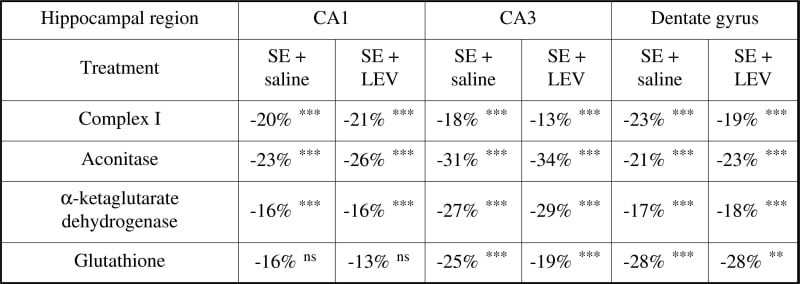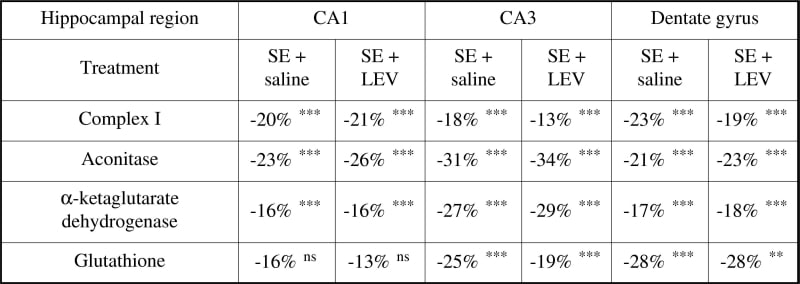Status epilepticus (SE) is a medical emergency that can result in permanent neurological damage (particularly to the hippocampus) and mental disability. Mitochondrial dysfunction has been implicated in the neuronal damage seen following SE (Cock et al. 2002). Levetiracetam (LEV) is a novel antiepileptic drug that has shown potential as a therapeutic agent for the treatment of SE (Mazarati et al. 2004) and is known to be neuroprotective (Hanon & Klitgaard 2001). Here we examine mitochondrial dysfunction in the hippocampus following SE and the effects of LEV. Perforant path stimulation was used as a model of SE; rats were anaesthetised with halothane and stimulating and recording electrodes were implanted stereotactically into the right perforant pathway and dentate granule cell layer respectively. 6 days later, the unanaesthetised, animals underwent 2h of perforant path stimulation (2-4mA at 20Hz) before i.p. administration of LEV (200mg/kg) or saline (1.2ml/kg). Self-sustaining chronic limbic status ensued, and continued for 3h before termination by diazepam (20mg/kg, i.p.). 44h later the rats were sacrificed humanely and both hippocampi extracted and dissected into 3 regions (CA1, CA3 and dentate gyrus). Spectrophotometric assays were performed on the samples to measure levels of mitochondrial respiratory chain and matrix enzymes in sham rats (n=8) compared to SE rats which received saline (n=5) or LEV (n=5). Additionally, levels of reduced glutathione (an antioxidant) were measured using electrochemical HPLC. When compared to shams, levels of mitochondrial enzymes and glutathione in the hippocampal regions were significantly reduced in the SE rats that received saline (see table). Citrate synthase and complex II/III were unaffected. This specific pattern of biochemical change confirms earlier findings with this model (Cock et al. 2002) and supports the notion that cell death following SE involves oxidative stress and excitotoxic mechanisms. Administration of LEV did not significantly protect against these biochemical changes (see table). Further experiments are underway to assess the influence of higher doses of LEV.
King's College London (2005) J Physiol 565P, PC62
Communications: Mitochondrial dysfunction in the hippocampus following status epilepticus: effects of levetiracetam
Gibbs, Julie E; Cock, Hannah R;
1. Epilepsy Group, Clinical Neuroscience, St Georges Hospital Medical School, London, United Kingdom.
View other abstracts by:
Percentage change in mitochondrial enzymes and glutathione levels following perforant pathway stimulation and treatment with saline or LEV compared to sham animals one way ANOVA and LSD ***p<0.005 **p<0.01.
Percentage change in mitochondrial enzymes and glutathione levels following perforant pathway stimulation and treatment with saline or LEV compared to sham animals one way ANOVA and LSD ***p<0.005 **p<0.01.
Where applicable, experiments conform with Society ethical requirements.


